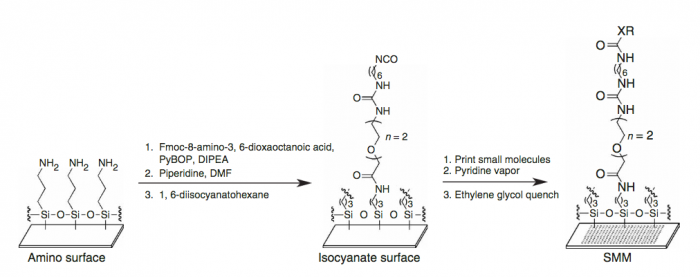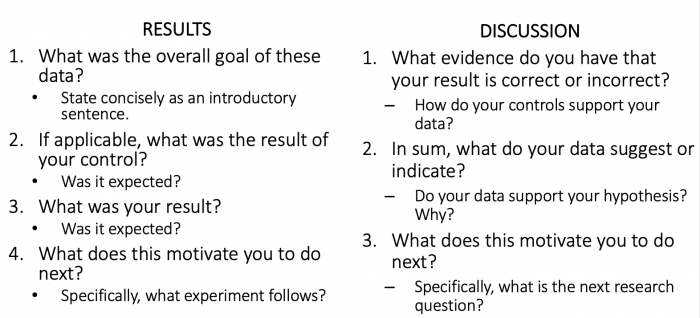Difference between revisions of "20.109(F23):M2D7"
Noreen Lyell (Talk | contribs) (→Part 1: Consider modifications that could improve binding to PfFKBP35) |
Noreen Lyell (Talk | contribs) (→Part 2: Consider other methods for small molecule discovery) |
||
| Line 50: | Line 50: | ||
(Written by Rob Wilson. For more information read Bradner, J. E., McPherson, O. M., and Koehler, A. N. (2006) ''A method for the covalent capture and screening of diverse small molecules in a microarray format.'' Nature Prot. 1:2344-2352. [http://www.ncbi.nlm.nih.gov/pubmed/17406478 PMID: 17406478].) | (Written by Rob Wilson. For more information read Bradner, J. E., McPherson, O. M., and Koehler, A. N. (2006) ''A method for the covalent capture and screening of diverse small molecules in a microarray format.'' Nature Prot. 1:2344-2352. [http://www.ncbi.nlm.nih.gov/pubmed/17406478 PMID: 17406478].) | ||
| + | |||
| + | |||
| + | *What is a downside of using this approach to identify small molecules that bind a specific target? | ||
| + | *What is an upside of using this approach to identify small molecules that bind a specific target? | ||
===Part 5: Draft discussion section for Research article=== | ===Part 5: Draft discussion section for Research article=== | ||
Revision as of 20:31, 7 November 2023
Contents
Introduction
Research takes time! The work that is reported in a published article is often a culmination of years of study by multiple investigators. Because of this it is very difficult to complete an entire project in the time span of a single semester. The work you completed this semester is part of an ongoing research project that started even before your previous classmates.
Previous work In work completed by the Fall 2022 class, students screened a library of small molecules that are chemically altered versions of FK506 which is known to bind to PfFKBP35 and the human ortholog, FKBP12. The goal of the initial screen was to examine the binding of each small molecule to PfFKBP35 and to FKBP12 in an effort to identify molecules that could potentially be used to target PfFKBP35 preferentially over FKBP12. From this experiment, the four small molecules used in your research were identified.
Your work The research goal for this module was to further study small molecules that were previously identified to bind to PfFKBP35. To better characterize the binding parameters of each of the four identified small molecules to PfFKBP35, you examined binding across different concentrations of small molecule. The Tm for PfFKBP35 across a range of small molecule concentrations can be used to confirm that binding is occurring and can also give some insight into the strength of the binding. If the small molecule binds to FfFKBP35, then a shift in the Tm will be observed and can be quantified by subtracting the Tm of PfFKBP35 without small molecule. The strength of binding can qualitatively be addressed by considering the concentrations of small molecule needed to cause a shift in the Tm. If a shift in Tm for a small molecule is observed at only high concentrations, then perhaps the strength of binding is not as good as for another small molecule that causes a shift in Tm at lower concentrations.
Future work There are several next steps that can be taken from your work. An obvious experiment is to test the small molecules used in your work with FKBP12 to confirm that the binding to PfFKBP35 is preferential across a range of concentrations of small molecule. If a small molecule passes this step, then perhaps modifications can be made to further improve the affinity and specificity to PfFKBP35. If a small molecule doesn't emerge as promising, then perhaps it is time to restart the screening process to identify new molecules.
Protocols
Part 1: Consider modifications that could improve binding to PfFKBP35
One method used to identify small molecules that bind to a specific target is to rationally design small molecules based on the structure information. If the structure of the protein target is known, then this information can be used to build a molecule that binds. In reality this is a very challenging task! To increase the chances of success using rational design, a scaffold molecule that is a known binder can be used. This is the approach that was used to develop the initial library of molecules that was screened by students in Fall 2022. The library was built by chemically modifying FK506, which is known to bind to PfFKBP35. This approach is only useful when a known small molecule binder is known. In addition, using this approach is not be useful in discovering molecules that bind outside of a known binding pocket or active site.
One method for assessing what functional groups are potentially important in protein-small molecule binding is to visually inspect known small molecule binders for common features / structures. As shown in the image below, common shapes can be identified between the small molecules.
In your laboratory notebook, complete the following:
- For the small molecules that showed binding from the class DSF results,
- are there any common features present?
- if there are common features, do these features resemble the functional groups you hypothesized would promote binding to PfFKBP35 in the exercise completed on M2D4?
- what might this suggest about the potential binding site(s) on PfFKBP35?
- How might you make modifications to the small molecules / features to improve binding to PfFKBP35?
- What is a downside of using this approach to identify small molecules that bind a specific target?
- What is an upside of using this approach to identify small molecules that bind a specific target?
Part 2: Consider other methods for small molecule discovery
In contrast to rational design, another method used to find small molecules that bind a protein of interest is to use a high-throughput screen, such as the SMM. Though we did not use this method as part of this module, the technology and the data analysis workflow will be briefly described below as this could be an alternative strategy to the approach used in this module. This technology enables researchers to screen thousands, to hundreds of thousands, of small molecules in an unbiased manner using commercially available libraries.
A small molecule microarray (SMM) requires the covalent attachment of a library of small molecules to a glass slide. Our library is meant to broadly sample the drug-like chemical space (i.e. all possible chemical structures that have drug-like physical properties) and contains about 50,000 small molecules. Some libraries are much smaller, while many pharmaceutical companies possess high-throughput screening (HTS) collections of millions of compounds. Because this chemical space is very large, it’s difficult to generalize any single chemical reaction for this attachment that can be applied to all small molecules. We take a “one-size-fits-most” approach, where the glass slide is functionalized with a broadly reactive electrophile capable of reacting with nucleophiles present in most drug-like small molecules, such as alcohols or amines. Many small molecules contain multiple nucleophiles suitable for attachment. In this case, our manufacturing will result in a mixture of attachment sites. It’s important to remember that attachment to the glass slide constrains the possible orientation of the protein-small molecule interaction; some orientations are not possible because the glass slide and linker are in the way.
We start with a glass slide with exposed amines across the surface and attach a short PEG (polyethylene glycol) linker. To the end of this PEG linker, an isocyanate group is attached. Isocyanate, or R-N=C=O, is a resonant structure, and a partial positive charge is stabilized on the carbon atom. This carbon atom is electrophilic, and small molecules with nucleophiles will react here. We estimate that about 70% of drug-like small molecules are amenable to this reaction, and our library is filtered to contain only these molecules.

Our compound library is dissolved in DMSO and stored in 384-well plates. To dispense the compounds onto our functionalized glass slide, a robotic arm with a set of 48 metal pins is used to transfer the compounds to the glass slide. Each metal pin has a small slit in the end, and capillary action is used to precisely withdraw and dispense consistent volumes. When the pins touch the glass slide, the compound in DMSO is dispensed into a small circle of approximately 160 micron in diameter. Each pin prints one compound in two different locations on each slide, and then the pins are washed in water and DMSO. This process is repeated for each compound, resulting in our final microarray. The microarray is divided into 48 subarrays, and each subarray corresponds to one pin and contains 256 discrete spots. Within each subarray, we print a set of fluorescent compounds in the shape of an ‘X’ so that we can precisely determine where each spot is printed. After the compounds react, we quench the surface so that no electrophiles remain. This results in our final microarray; a collection of approximately 12,000 discrete spots displaying one compound each.
(Written by Rob Wilson. For more information read Bradner, J. E., McPherson, O. M., and Koehler, A. N. (2006) A method for the covalent capture and screening of diverse small molecules in a microarray format. Nature Prot. 1:2344-2352. PMID: 17406478.)
- What is a downside of using this approach to identify small molecules that bind a specific target?
- What is an upside of using this approach to identify small molecules that bind a specific target?
Part 5: Draft discussion section for Research article
As the final section of your Research article, you will write a formal Discussion that summarizes the key findings and states the implications of your research. Use the homework you completed for today to draft the Discussion for your Research article.
Remember that the Results and Discussion information will be separate in this more formal writing assignment. Use the questions below to help you decide which details should be included where in your text.
Next day: Brainstorm ideas for Research Proposal presentation


